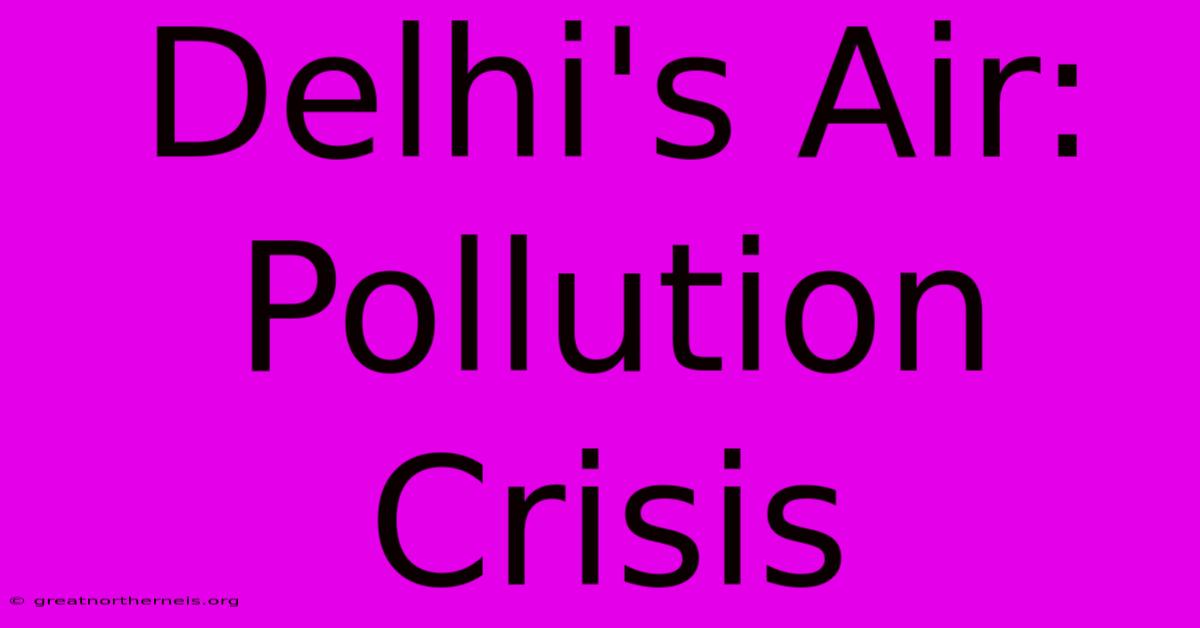Delhi's Air: Pollution Crisis

Discover more detailed and exciting information on our website. Click the link below to start your adventure: Visit Best Website mr.cleine.com. Don't miss out!
Table of Contents
Delhi's Air: A Suffocating Pollution Crisis
Delhi, India's bustling capital, faces a chronic and severe air pollution crisis. This isn't just an environmental issue; it's a public health emergency impacting millions and demanding immediate and comprehensive solutions. The alarming levels of pollutants in Delhi's air threaten the well-being of its residents and necessitate a multi-pronged approach involving governmental intervention, technological advancements, and a significant shift in societal behavior.
The Sources of Delhi's Air Pollution: A Deadly Cocktail
The air quality in Delhi is a complex mixture of pollutants from various sources, creating a dangerous cocktail with devastating consequences. Key contributors include:
1. Vehicular Emissions:
- High traffic density: Delhi's roads are choked with vehicles, emitting significant quantities of particulate matter (PM2.5 and PM10), nitrogen oxides (NOx), and carbon monoxide (CO). The sheer number of vehicles, coupled with a large percentage of older, less efficient models, exacerbates the problem.
- Construction and demolition activities: Dust from construction sites contributes significantly to the particulate matter pollution, further degrading air quality.
2. Industrial Emissions:
- Industries surrounding Delhi: Numerous industries located in and around Delhi release pollutants into the atmosphere, impacting air quality across the city. Lack of stringent regulations and enforcement allows for unchecked emissions from various industrial processes.
3. Burning of Waste:
- Municipal solid waste: Open burning of garbage, particularly common in informal settlements, releases harmful pollutants including dioxins and furans. This practice is widespread and contributes considerably to the city's poor air quality.
- Agricultural stubble burning: The practice of burning agricultural stubble in neighboring states during harvesting season significantly worsens air quality in Delhi, contributing a large proportion of PM2.5.
4. Seasonal Factors:
- Winter Inversion: During winter months, a temperature inversion traps pollutants close to the ground, leading to a significant spike in pollution levels. This atmospheric phenomenon amplifies the impact of other pollution sources.
The Devastating Health Impacts of Delhi's Polluted Air
The consequences of Delhi's air pollution are severe and far-reaching, impacting the health and well-being of millions:
- Respiratory illnesses: Increased rates of asthma, bronchitis, and other respiratory diseases are directly linked to prolonged exposure to polluted air.
- Cardiovascular problems: Air pollution contributes to heart attacks, strokes, and other cardiovascular issues.
- Cancer: Studies have linked long-term exposure to air pollutants to an increased risk of lung cancer and other cancers.
- Reduced lung function: Especially in children, air pollution stunts lung development, leading to long-term respiratory problems.
Combating the Crisis: Strategies for Cleaner Air in Delhi
Addressing Delhi's air pollution requires a multi-faceted approach involving various stakeholders:
1. Governmental Interventions:
- Stricter emission norms: Implementing and enforcing stricter emission standards for vehicles and industries is crucial.
- Promoting public transportation: Investing in and improving public transportation systems can reduce reliance on private vehicles.
- Sustainable waste management: Implementing effective waste management systems to minimize open burning and promote recycling.
- Controlling industrial emissions: Enforcing stringent regulations and monitoring industrial emissions to reduce pollution.
2. Technological Solutions:
- Real-time air quality monitoring: Expanding and improving air quality monitoring networks can provide better data for informed decision-making.
- Pollution control technologies: Implementing advanced pollution control technologies in industries and vehicles can significantly reduce emissions.
3. Public Awareness and Behavioral Change:
- Promoting cycling and walking: Encouraging the use of non-motorized transportation can reduce vehicular emissions.
- Reducing reliance on private vehicles: Promoting carpooling and the use of public transport.
- Raising awareness: Educating the public about the health risks of air pollution can encourage behavioral change.
Conclusion:
Delhi's air pollution crisis is a serious and urgent issue demanding immediate and sustained action. A collaborative effort involving the government, industries, and citizens is essential to improve air quality and protect the health and well-being of Delhi's residents. Only through a comprehensive and long-term strategy can Delhi hope to breathe cleaner air. The future of Delhi's air quality depends on the collective commitment to finding sustainable solutions and implementing them effectively.

Thank you for visiting our website wich cover about Delhi's Air: Pollution Crisis. We hope the information provided has been useful to you. Feel free to contact us if you have any questions or need further assistance. See you next time and dont miss to bookmark.
Featured Posts
-
Abr Holdings Mds Key To Growth
Nov 26, 2024
-
Delhi Pollution Everyday Dystopia
Nov 26, 2024
-
Three Sabah Tyt Candidates In The Spotlight
Nov 26, 2024
-
Abr Holdings Sees Continued Growth
Nov 26, 2024
-
Updated Ravens Vs Chargers Week 12 Injuries
Nov 26, 2024
